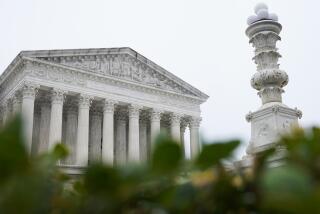Desegregation Decision’s True Legacy : Brown failed in is stated aim, but it has succeeded in turning judges into social engineers.
Friday was the 42nd anniversary of Brown vs. Board of Education, perhaps the most famous of all Supreme Court decisions. That decision did two things. One, well-known, desegregation of the public schools, has come to naught after years of federal coercion.
Brown’s real achievement is largely unknown, despite its far-reaching consequences. Brown destroyed the separation of powers that was artfully crafted by the Founding Fathers, and in a direct assault on self-rule launched the era of judicial legislation.
Alexander Bickel, who, as Justice Felix Frankfurter’s law clerk played a key role in engineering the Brown decision, later had second thoughts. In 1970, he wrote: “Brown vs. Board of Education was the beginning. Subsequently, the court declared Bible reading and all other religious exercises in public school unconstitutional; it ordered the reapportionment of the national House of Representatives, of both houses of state legislatures, and of local government bodies.”
Lino Graglia of the University of Texas Law School has written that Brown created the presumption that decision-making by the Supreme Court on the basis of moral principle is greatly superior to decision-making by politicians subject to electoral constraints. This allowed the court to legislate the liberal agenda by decree, “such as the removal of restrictions on abortion and pornography, the imposition of a novel liberalized code of criminal procedure on the states . . . and the abolition of prayer and Bible reading in public schools.”
The justices themselves knew what they were doing. Hugo Black said that Brown would lead to “law by injunction.” Robert H. Jackson regarded Brown as a blatantly political act. Stanley Reed said Brown would lead to rule by judges, and it has.
Brown failed in its stated aim, but it has succeeded in transforming the judiciary from judges to social engineers. Today there is no democratic outcome that a federal judge cannot overturn.
Since 1954, constitutional law has consisted of the liberal agenda. Decades of precedent based on nothing but judicial diktat grounded in the personal preferences of judges make it difficult for justices like Antonin Scalia who think the court should decide its cases based on law and precedent.
Brown’s violation of the separation of powers has, in effect, destroyed law, at least in the American sense of law that is accountable to the people.
The court as legislator has been devastating for both political parties. The Democrats are divided over racial quotas and same-sex marriage, and Republicans are split over abortion. The lack of political cohesion makes both parties impotent.
In public universities, integration was achieved by granting “preferred minorities” privileged admission status in direct violation of the equal protection clause of the Constitution and the statutory prohibition against reverse discrimination in the 1964 Civil Rights Act. Until the Hopwood vs. Texas decision by the 5th Circuit Court of Appeals in March, the courts winked at the illegality of racial quotas in the interest of a higher morality: integration.
With the 5th Circuit’s ruling that racial preferences in admissions are unconstitutional, ideological liberals have reverted to states’ rights arguments in their effort to protect racial quotas in university admissions. In words lifted from the segregationists of yesteryear, Harvard’s Laurence Tribe, argues that in overturning the University of Texas’ racial quotas, the appeals court violated the state’s “sovereign immunity contained in the 11th Amendment.”
In the end Brown has made monkeys out of liberals who worship at its shrine. If states’ rights prohibit federal courts from interfering with school admission policies, Brown could never have been decided.
Brown was the product of the liberal elite’s impatience with democracy and persuasion. It reflects the arrogant determination to seize power in order to impose morality on an unjust social order.
The failure of school integration is being blamed on segregated neighborhoods. Liberal writers such as Jacob Weisberg and Mickey Kaus say the solution is to forcibly integrate the neighborhoods. This is already happening in a small way. In the mid-1980s, Yonkers, N.Y., was forced by a federal judge to construct public housing to integrate its neighborhoods, and HUD uses Section 8 funds to subsidize the rents of inner-city blacks who move to white suburbs.
It remains to be seen whether this is a last gasp or whether the federal coercion unleashed by Brown has yet a way to run.
More to Read
Sign up for Essential California
The most important California stories and recommendations in your inbox every morning.
You may occasionally receive promotional content from the Los Angeles Times.










